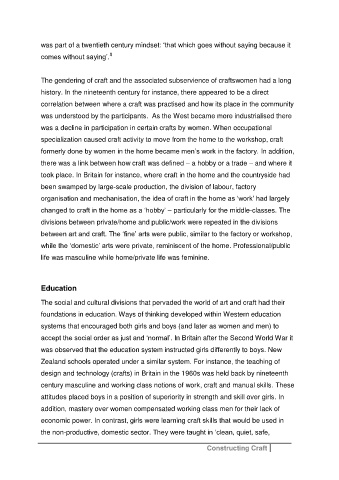Page 246 - Constructing Craft
P. 246
was part of a twentieth century mindset: ‘that which goes without saying because it
8
comes without saying’.
The gendering of craft and the associated subservience of craftswomen had a long
history. In the nineteenth century for instance, there appeared to be a direct
correlation between where a craft was practised and how its place in the community
was understood by the participants. As the West became more industrialised there
was a decline in participation in certain crafts by women. When occupational
specialization caused craft activity to move from the home to the workshop, craft
formerly done by women in the home became men’s work in the factory. In addition,
there was a link between how craft was defined – a hobby or a trade – and where it
took place. In Britain for instance, where craft in the home and the countryside had
been swamped by large-scale production, the division of labour, factory
organisation and mechanisation, the idea of craft in the home as ‘work’ had largely
changed to craft in the home as a ‘hobby’ – particularly for the middle-classes. The
divisions between private/home and public/work were repeated in the divisions
between art and craft. The ‘fine’ arts were public, similar to the factory or workshop,
while the ‘domestic’ arts were private, reminiscent of the home. Professional/public
life was masculine while home/private life was feminine.
Education
The social and cultural divisions that pervaded the world of art and craft had their
foundations in education. Ways of thinking developed within Western education
systems that encouraged both girls and boys (and later as women and men) to
accept the social order as just and ‘normal’. In Britain after the Second World War it
was observed that the education system instructed girls differently to boys. New
Zealand schools operated under a similar system. For instance, the teaching of
design and technology (crafts) in Britain in the 1960s was held back by nineteenth
century masculine and working class notions of work, craft and manual skills. These
attitudes placed boys in a position of superiority in strength and skill over girls. In
addition, mastery over women compensated working class men for their lack of
economic power. In contrast, girls were learning craft skills that would be used in
the non-productive, domestic sector. They were taught in ‘clean, quiet, safe,
Constructing Craft

